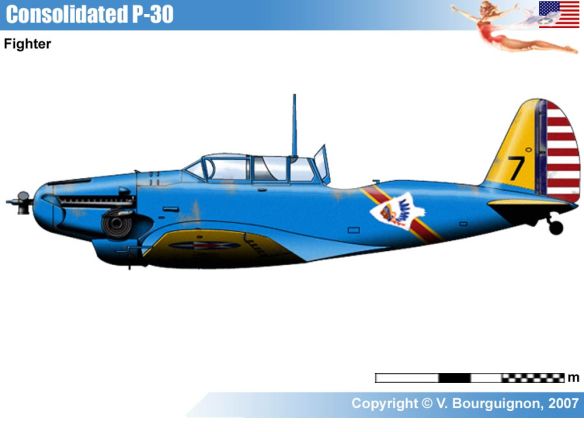The first service monoplane biplane fighter was the P-30, quickly redesignated PB-2 to reflect the accommodation. It was a useful heavy fighter, particularly at low level, and it remained in service beyond 1940.
By 1934, flight tests of the P-30 were under way the aeroplane carrying an officer/pilot and enlisted man/gunner. Pilots bred on the romance and appeal of the single-seat pursuit ship were not readily won-over by a two-seat machine. Gunners found their semi-open perch aboard the P-30 distinctly uncomfortable and, at high altitude, very cold. Reports that rear gunners sometimes ‘blacked out’ during high-g manoeuvres appear erroneous, but the heavy clothing, required to keep the gunner from Freezing, seriously impaired his effectiveness. For this and other reasons, the P-30 was never effective at high altitude, the very regime where USAAC doctrine called for it to fly and fight. Development of the parallel A-11 attack aircraft was suspended after delivery of four airframes and some airmen argued that the P-30, too, had reached the limit of its usefulness. But on 6 December 1934, the Army placed a firm contract for a production batch of 50 P-30As (35-1150) and made lam for the 1st Pursuit Group at SeIfridge Field, Michigan, to operate the type. The operational machines received the 700-hp (522-kW) Curtis V- 1570-61 powerplant. They became a familiar sight in war games at USAAC aerodromes during the 1930s.
A single P-30A was built as a single-seater and competed without success in the 1936 fighter competition which produced the Curtiss P-36 Mohawk. Shortly after the P-30A entered service, the ‘pursuit bi-place’ category was closed, surviving P-30 airframes becoming PB-2s and the single-seat P-30A becoming the PB-PA. This heavy and heavily-armed fighter was to take in one further designation in an unbuilt variant, XP-33, before passing into history. A few PB-2As (former P-30As) are thought to have remained in service as late as the eve of Pearl Harbor.
Variants
Y1P-25
Further development of Lockheed YP-24 with all-metal wing, 600 horsepower (450 kW) Curtiss V-1570-27 Conqueror turbosupercharged engine. Two fixed forward firing .30 in machine guns and one flexibly mounted gun in rear cockpit. One built.
Y1A-11
Ground attack version of Y1P-25. Powered by unsupercharged engine and armaent of 4x forward firing .30 in guns in nose, one in rear cockpit and up to 400 lb (182 kg) of bombs. One built.
YP-27
Proposed variant of Y1P-25 with 550 horsepower (410 kW) Pratt & Whitney R-1340-21G Wasp radial engine. Unbuilt.
Y1P-28
Proposed variant of Y1P-25 with 600 hp R-1340-19 Wasp; unbuilt.
P-30
Initial production batch for Army Air Corps. 675 horsepower (503 kW) V-1570-57 turbosupercharged engine. Four built, later redesignated PB-2.
A-11
Initial production ground-attack aircraft, with unsupercharged V-1570-59 engine. Four built.
P-30A
Main production fighter powered by 700 horsepower (520 kW) turbosupercharged V-1570-61 engine; 50 built, redesignated PB-2A.
PB-2A Special
Seventh PB-2A modified to single-seat configuration. Crashed during flight testing.
XP-33
Proposed version with 800 horsepower (600 kW) Pratt & Whitney R-1830-1 Twin Wasp engine; unbuilt.
XA-11A
Conversion of A-11 as testbed for 1,000 horsepower (750 kW) Allison XV-1710-7. One converted.
Specifications (PB-2A)
General characteristics
Crew: 2
Length: 30 ft 0 in (9.14 m)
Wingspan: 43 ft 11 in (13.38 m)
Height: 8 ft 3 in (2.51 m)
Wing area: 297 ft (27.6 m)
Empty weight: 4,306 lb (1,950 kg)
Loaded weight: 5,623 lb (2,556 kg)
Powerplant: 1 × Curtiss V-1570-61 Conqueror liquid-cooled V12 engine, 700 hp (520 kW)
Performance
Maximum speed: 275 mph (239 knots, 443 km/h) at 25,000 ft (7,620 m)
Cruise speed: 215 mph (187 knots, 346 km/h) at 15,000 ft (4,600 m)
Range: 508 mi (442 nmi, 818 km)
Service ceiling: 28,000 ft (8,530 m)
Climb to 15,000 ft (4,600 m): 7 min 48 s
Armament
Guns:
2 x 0.30 in (7.62 mm) machine guns firing through the propeller
1 x 0.30 in machine gun in the rear cockpit
Bombs: 170 lb (80 kg) bombs
